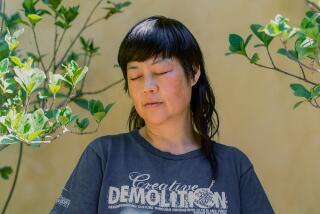PERFORMANCE ART REVIEW : MONK AND CHONG OFFER âGAMESâ AT ROYCE HALL
You wouldnât expect 90 minutes of Pina-servitude from Meredith Monk or Ping Chong, two of the most intuitively, ruminatively original American artists working in dance-based performance art. But, collaborating in Berlin in 1983, they created âThe Games,â a hard-edged multimedia spectacle (a k a opera) very much in the shadow of Bauschian Tanztheater .
Indeed, in the Brooklyn Academy of Music âNext Waveâ staging, seen at Royce Hall, UCLA, on Wednesday, the stance of Germanic Neo-Expressionism seemed to dictate form, content and, at times, language (German speech with English slide-titles). But, for all its versatility, the 18-member Brooklyn contingent couldnât match the sense of risk that Bauschâs company wears like a badge of honor.
When, in the fourth episode, little scenes of betrayal and threat gave way to mass running and flailing, the blatant emotional fakery of the cast turned the portrayal of consuming terror into a silly charade.
To be sure, depicting the use of games as a form of social conditioning allowed Monk and Chong to incorporate major elements of Yankee formalism, yet even these traces of something authentically theirs never yielded anything but off-the-rack radical chic.
Set against enormous textured-steel walls by Yoshio Yabara that evoked a futuristic stockade or space-station interior, âThe Gamesâ traced the training and indoctrination of a group through competitions testing physical speed and dexterity, personal interaction and the memory of a culture very much like ours but presumably long ago and far away.
âWhen was the question mark invented and by whom?â the voice of Big Sister (or Gamesmaster) demanded. No takers. âWas sushi a popular dance or a religious sect?â The corps executed structuralist movement sequences--part communal exercise but also more indoctrination, for, as the slide screen reminded us, âform is good, form is reason, reason is truth.â And truism is art, evidently.
From time to time, we heard snatches of a ricky-tick pop tune. Like the one in Bauschâs â1980,â it served as the accompaniment to a mock-nostalgic dance sequence--the dead-end of pop culture.
Monkâs own characterization of the Gamesmaster seemed closely modeled on a previous Americanization of an Expressionist archetype: the ever-smiling, increasingly menacing Joel Grey M.C. in the musical âCabaret.â It exploited her octave-swooping vocalism and sharply etched movement style but virtually nullified both her womanhood and sense of poetic ambiguity. And for what?
Her propulsive score required greater virtuosity from the company than the choreography that she, Chong and Gail Turner devised. Moreover, in far more sophisticated ways than Bausch has used music, it supported and deepened the theatrical events.
The atmospheric ending--with its celestial vocalise and weighty space walk, its visions of a receding planet and hooded bard-bagpiper--did liberate the audience from the schematic game structures and the obvious points they underlined, but by then it was too late.
âThe Gamesâ had toyed with so many familiar conceits and developed so few of them into definitive statements that it emerged inescapably second-hand and second-rate--a big production in which Monk and Chong seemed less auteurs than victims.
More to Read
The biggest entertainment stories
Get our big stories about Hollywood, film, television, music, arts, culture and more right in your inbox as soon as they publish.
You may occasionally receive promotional content from the Los Angeles Times.










